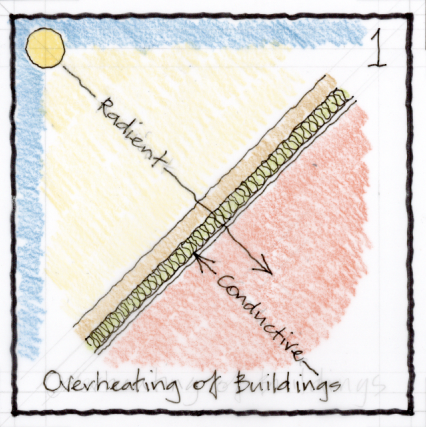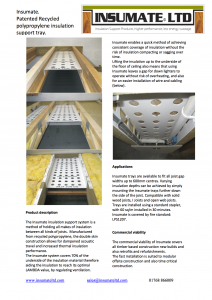
GBE Spray Foam Thermal Insulation Q+A
GBE > Encyclopaedia > Code > Question+Answer > G#40648
About:
LinkedIn Q&A
Statement S1
- I keep hearing about this spray foam ‘solution’.
- Spray foam to me has always been a no no.
Question Q1
- Thoughts?
- Paul Bourgeois
Answer A1
Airtightness
- Spray foam is a temporary solution to achieving airtightness.
- Air leakiness enables heat loss or coolth gain and combined with moisture vapour, risks of condensation, mould, rot, structural failure and frost damage.
- If the surfaces it is sprayed onto are not clean, dry, dust-free, primed, the risk of the shrinking foam will not adhere and pull away, no longer airtight.
Material & Embodied Carbon
- Spray foam is usually hydrocarbon (a finite resource) petrochemical plastic from fossil carbon oil and with potentially polluting chemical process waste
- There was a bio-based foam (rapidly renewable, plant based, carbon negative due to carbon sequestration) on the market, but when challenged by a specifier, found keeping supply chain audit trails to sustainable sources challenging and they switched to back to petrochemical.
- A too clever-clog specifier (might even be a violet) that caused a switch from carbon-negative to carbon-positive resource.
Closed cell plastic foam insulation
- Closed-cell foamed-plastic is usually air-tight and moisture vapour tight; so it is risky in conjunction with timber construction
- The insulation create barrier to moisture permeability and the only way out is through the timbers
- Some older roofs have been destroyed by enveloping the timbers so unable to breath and keep dry.
- There is a video showing lumps of the insulation being pulled out of the installation and squeezing water from the foam.
- That video did not interrogate the cause, just the symptoms, so we do not know if it was caused by:
- leaking roof,
- surface condensation from the underside of the roof tiles
- interstitial condensation in the foam.
- There is one manufacturer that produces an open cell moisture permeable sprayed foam insulation
Spray foam insulation and bats
- One badly behaved manufacturer/installer has instructed a second team of installers to spray roofs where bats were known to roost, discovered by their first team who declined to do the work, and trapped or entombed hundreds of bats to die.
- £5000/bat fines should be enough to stop this behaviour
Unhealthy foam insulation?
- There are numerous examples of where the occupants have suffered ill health due to off gassing from foaming plastic insulation, so bad that they cannot re-enter their buildings.
- Effectively destroying their investment.
- Nuff said?
Airtightness measures:
- Rigid board foam insulation probably does not snug-fit against timber frame members.
- Cutting to profile, using a blade could be good, but not easy
- Cutting with a hot-wire will probably produce toxic smoke or emissions.
- Cutting with a saw will produce millions of micro-plastics that will not normally be collected, so will be wind blown and work its way into drains, sewers, to the oceans.
- ‘GapOtape’ solves the leakiness issue by wrapping the edges of the boards with a foam strip adhered with self adhesive aluminium foil.
- But using airtight insulation between timber framing seems instinctively wrong.
Summer overheating?
- Foamed plastics are good at winter thermal conductivity insulation
- But they lack density and specific heat capacity
- They will let radiant solar heat gains to pass straight through the insulation
- Once inside the heat cannot get back out due to thermal conductivity insulation
- This leads to overheating
Insulation between rafters?
- There is a plastic support system for insulation in between rafters
- Its made of PVC
- GBE have encouraged its manufacturer for consider alternatives to PVC
- It can support quilt and batt insulation avoiding the need for spray foam
Suspended timber ground floors
- Limited access can mean insulation of a suspended ground floor needs to be insulated from above after removing the floor boards.
- Using a purpose made support system stapled to the floor joists then batt insulation installed from above.
- See Insumate product range Accessories in right column
- Then regularised and sanded boards can be relaid
Robot insulating machine?
- There is a system of insulating using a robot on wheels to spray foaming insulation into the joint zone from below.
- This still needs to be moisture permeable and wind resistant and conductivity thermal insulation
- It does not need to have specific heat capacity since the sun does not reach here.
© GBE GBC GRC GBL NGS ASWS Brian Murphy aka BrianSpecMan **
20th November 2019 – 15th April 2023
Images


Brian Murphy aka BrianSpecMan BRM @ Build4 CAPEM Showroom


See Also:
GBE Sign Up
- GBE Membership (Sign-Up) G#23472
GBE #Hashtags
GBE Slogans
- Build Light Insulate Right Solar Tight (Slogan) G#2272
- Fabric First Materials First Performance First (Slogan) G#17243
- Stuffed Loft; Squashed Insulation; Lift Your Loft Stuff (Slogan) G#13957
GBE Q&A
Legend
- Statement No.: S1, S2, etc.
- Observation No.: O1, O2, etc.
- Comment No. C1, C2, etc.
- Question No.: Q1, Q2, etc.
- Answer No.: A1, A2, etc.
Pages
- Phased Barn Conversion Temporary Flooring (Q+A) G#2788
- Energy Saving and Noise Reduction (Q+A) G#3204
- Suspended timber floor retrofit insulation (Q+A) G#3870
- Thermal insulation existing timber stud external walls (Q+A) G#1803 N#1690
- Energy and Acoustics Measures (Q+A) G#1484 N#1444
- Primitive Materials Future Building (Q+A) G#16244
- Sustainable Design Manufacturer’s Information (Q+A) G#20468
GBE Checklist
- Decent Homes (Checklist) G#1571 N#1507
- Refurbishment Decent Homes (Checklist) G#1253 N#1252
- Green Deal Refurbishment (Checklist) G#730 N#752
- Other issues (Checklist) G#1570 N#1506
- GBE New Build Checklist (Navigation) G#606 N#627
- A10 Project Particulars (Checklist) G#1696 N#1598
- A11 Tender and Contract Documents (Checklist) G#1697 N#1599
- A12 The Site/Existing Buildings (Checklist) G#1698 N#1600
- A90 Performance Specification (Checklist) G#1715 N#1617
- A91 Prescriptive Specification (Checklist)
- A93 Performance Testing Off-site Mock-up Test rigs (Checklist) G#1719 N#1621
- A94 Airtightness testing on-site (Checklist) G#1720 N#1622
- A95 Infra-Red Thermographic Surveys (Checklist) G#1721 N#1623
- C Existing Site/Building/Services (Checklist) G#1558 N#1498
- C10 Site Survey (Checklist) G#1559 N#1499
- G Structural/ Carcassing metal/ timber (Checklist) G#1596 N#1526
- G20 Carpentry Timber Framing First Fixing (Checklist) G#1597 N#1527
- H Claddings Coverings (Checklist) G#1735 N#1635
- H21 Timber Weatherboarding (Checklist) G#11946
- M21 Insulation With Rendered Finish (Checklist) G#9442
- Z10 Purpose Made Joinery (Checklist) G#1593 N#1524
GBE Issue Papers
- Squashed Loft Insulation (Issue Paper) G#13919
GBE CPD
- Surveys Tests Analysis (CPD Lecture) G#389 N#390
- Refurbishment Decent Homes Checklist (CPD) G#644 N#666
- Retrofit PAS 2035 (CPD) G#21613
- Sustainable Refurbishment Materials Specification (CPD) G#38046
GBE Lectures
- (13.1) Ground Floor (Lecture) G#2112 N#213
- (21) Timber Frame (Lecture) G#2117 N#219
- (27.2) Pitched Roofs (Lecture) G#2122 N#224
GBE Shop
- GBE Lecture (13.1) Ground Floors (Shop) G#11561
- GBE Lecture (21) Masonry External Walls (Shop) G#11559
- GBE Lecture (23) Upper Floors (Shop) G#11554
- GBE Lecture (27.1) Flat Roofs (Shop) G#11501
- GBE Issue Paper Overheating (Shop) G#10433
- LoftZone StoreFloor CPD Handout (Shop Free) G#16383
- LoftZone StoreFloor CPD (Shop) G#16381
GBE Defects
- Weather Protection (Defect) G#728 N#750
- Attic cistern thermal insulation enclosure (Defect) G#1041 N#1058
- Loft Insulation (Defect) G#14166
GBE Calculators Shop
- GBE Calculator Whole Building Uvalue to In Use Carbon A06 XLS (Shop) G#11095
- GBE Calculator Whole Building Uvalue to In Use Carbon A05 XLSX (Shop) G#11009
GBE Issue Papers
- Squashed Loft Insulation (Issue Paper) G#13919
- Overheating (Issue Paper) G#145
GBE Brainstorms
GBE Products
- Diathonite Evolution (Product) G#1796 N#1683
- Breathaplasta (Product)
- Breathaboard (Product)
GBE Accessories
- Insumate 600 Tray (Accessories) G#1762 N#1658
GBE Systems
GBE Materials
- Aerogel
- Cellulose flake recycled newspaper
- Clayboards
- Clay plasters
- Dense wood fibre Insulation
- Glass wool
- Hemp-lime
- Stone wool
- Vacuum Insulated Panel (VIP)
GBE Manufacturers of other materials
- Adaptavate (Manufacturer)
- Ampack
- Argilus
- EBB
- Eco Answers Ltd t/a LoftZone (Manufacturer) G#13890
- Enviroform Solutions Ltd (Manufacturer) G#4728
- GapOTape
- Gutex
- Insumate Ltd (Manufacturer) G#1761 N#1657
- Lime Technology
- Pavatex
- ProClima
- Schneider
- Steico
- Ty-Mawr Lime Ltd (Manufacturer) G#891 N#911
- Unger Diffutherm
GBE Suppliers of other materials
- Back to Earth (Supplier)
- Eco Answers Ltd t/a LoftZone G#13890
- EcoMerchant (Supplier) G#887 N#907
- Ecological Building Systems (Supplier) G#886 N#906
- Mike Wye & Associates (Supplier) N#910
- NBT Natural Building Technology (Supplier)
- Partel (Supplier)
- Ty-Mawr Lime Ltd (Manufacturer Supplier) G#891 N#911
GBE Installers
GBE Servers
- Enviroform Solutions Ltd G#4728 (advice on all insulation types, provide fit for purpose solutions)
© GBE GBC GBL NGS ASWS Brian Murphy aka BrianSpecMan **
15th April 2023

